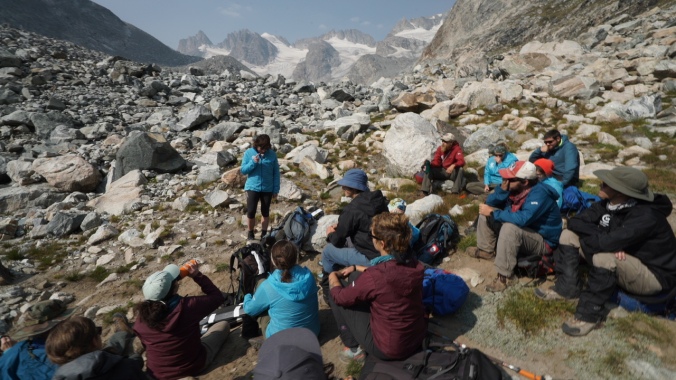Interdisciplinary Climate Change Expedition Research
Interdisciplinary Climate Change Expedition Research
Twenty students and faculty from Central Wyoming College made startling discoveries at the base of Gannett Peak, Wyoming’s highest mountain, and on the Dinwoody Glacier during late August.

Archaeology, Environmental Science, and Outdoor Education students on the Inter-disciplinary Climate Change Expedition (ICCE) researched various hydrological and archaeological aspects of the glacier and high mountain environment including human occupations of the area during the last twelve thousand years.

Nearly two meters of the upper surface of the Dinwoody Glacier have melted in the twelve months since mid-August 2014. Rapid glacial ice loss has serious implications for downstream communities including the Wind River Indian Reservation, Lander, and Riverton.
Students are gathering additional data with ground penetrating radar to try to calculate the depth and volume of ice remaining in the glacier which, along with the other shrinking ice masses, still provides consistent irrigation water for the Wind River Basin. Other students sampled snow to measure the amount of black carbon present and to assess whether black carbon (the result of incomplete combustion of carbon-based fuels) might be exacerbating glacial ice melt. Finally, although students hypothesized that heavy use by climbers and campers might be impacting water quality by contributing E. coli to surface waters adjacent to high mountain campsites, field incubation of water samples demonstrated no evidence of bacterial contamination.



CWC archaeologists were thrilled to discover what preliminary evidence suggests is Wyoming’s highest-known buffalo jump on a barren, rocky mountainside at 11,000 feet above sea level. Most jumps are in the basins of Wyoming, Montana and the plains states at much lower elevations, typically between 3,000 and 8,000 feet. Prehistoric mountain sheep traps are known in the high mountains, but this discovery adds a new component to the growing field of high-elevation archaeology. Additional discoveries included several campsites that may have been used by Paleoindian mammoth hunters and their descendants. Additional fieldwork is planned to further all these natural and cultural studies in 2016.
Students majoring in Environmental Health, Outdoor Education, and Archaeology under Professors Jacki Klancher, Darran Wells, and Todd Guenther participated in the eleven day expedition. Sarah Konrad and Elizabeth Traver from the University of Wyoming assisted with field research, and Wyoming PBS Senior Produce Kyle Nicoloff coordinated filming for an upcoming PBS documentary on the implications of glacial ice loss.


Students use global positioning systems to collect data, and computer-based mapping software to prep and present their data; they employ their mountaineering training to traverse the glacier safely, and to sample snow, ice and water; and they apply their archaeology training to piece together human history. “Collectively, with six different research projects underway, we are a highly complex mission, and the details verge on overwhelming. The logistics of performing research and safely leading students in remote, high elevation terrain demands full focus by all of our team members,” says Klancher “Amongst the faculty leading this expedition, and with contributions from visiting scientists from UW, we have an extensive skill set . We rely heavily on the mountaineering skills and leadership provided by CWC Outdoor Education Professor and NOLS Instructor Darran Wells to guide our mountaineering teams, but Darran has also jumped in with both feet to guide the glacier GPR and repeat glacial photography. Todd Guenther provides leadership in the Archaeological realm and has a skill set in this realm that is entirely unique – we cannot fill his shoes in the field!”
This team is fully cognizant of the benefits of active learning, Says Wells: “students learn so much more in the field, they are fully engaged, and this applied experience in a multi-year research project gives them an advantage when applying for jobs and higher degree programs after CWC.”
2015 ICCE research student, Ian McGlynn, adds the following: “I feel honored to have been a part of ICCE 2015. As undergraduates, it’s amazing that we get to partake in such complex and pertinent research. It was a great experience working with Darran Wells, Jacki Klancher, and the rest of the ICCE to investigate an issue that is so relevant to the Lander, Riverton, and Wind River Reservation areas. This expedition gave me a first-person perspective on the issue of climate change, and just how urgent it really is. Dragging a 100MHz GPR antenna across a rapidly melting, boulder ridden ice field really explained why research on these alpine glaciers is so rare. I hope to be a part of ICCE next year so we can continue to monitor the health of the Dinwoody Glacier and perhaps isolate any additional contributors to its rapid recession.
2660 Peck Avenue
Riverton, WY 82501
(307) 855 – 2000
Campus Map
120 Enterprise Blvd.
Lander, WY 82520
(307) 332 – 3394
Campus Map
240 S. Glenwood St #124
P.O. Box 4795
Jackson, WY 83001
(307) 733 – 7425
Campus Map
302 W. Ramshorn
P.O. Box 175
Dubois, WY 82513
(307) 455 – 2625
Campus Map
© 2024 Central Wyoming College – All Rights Reserved